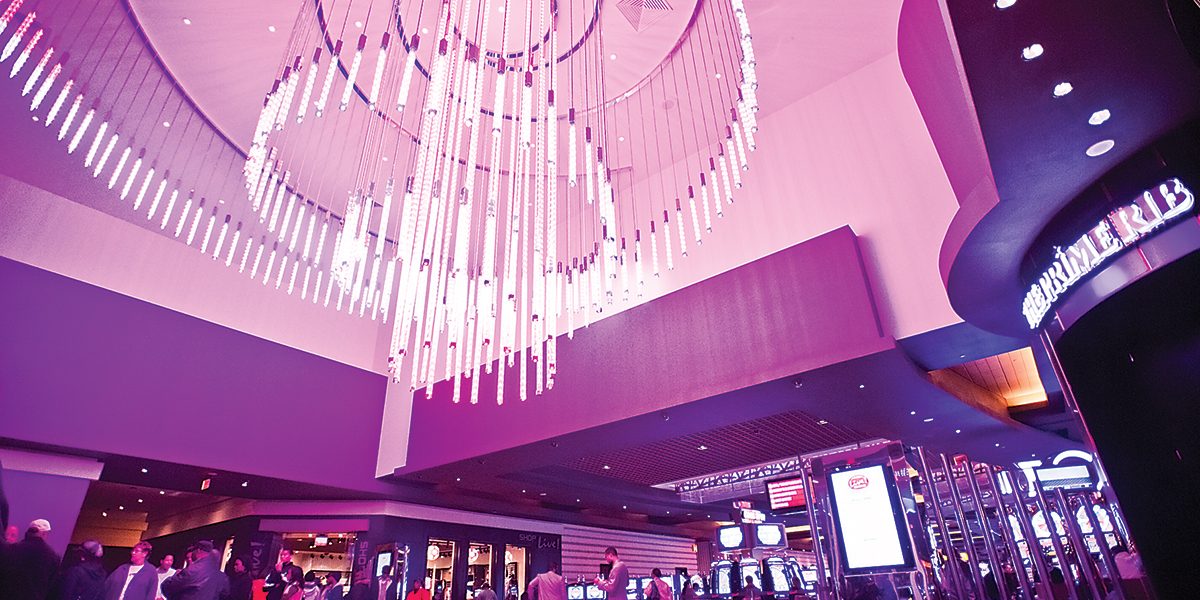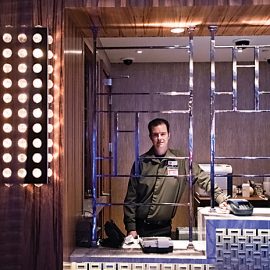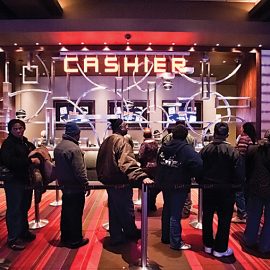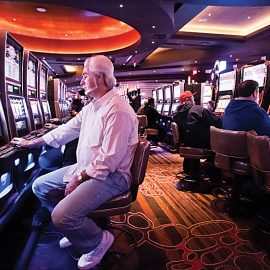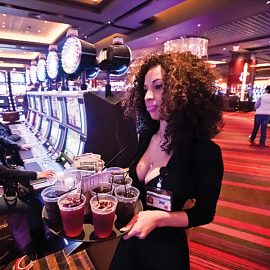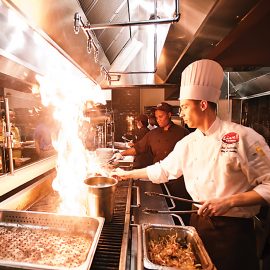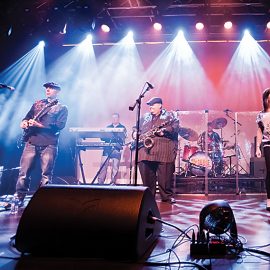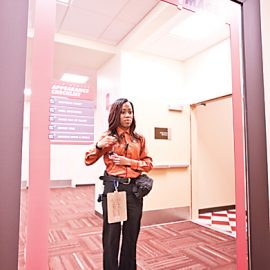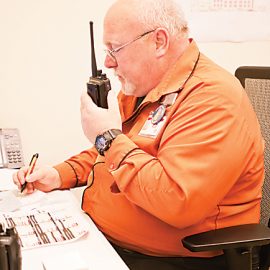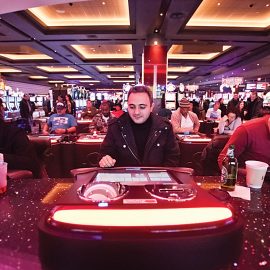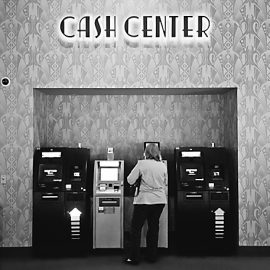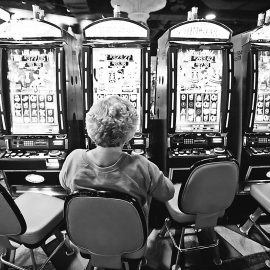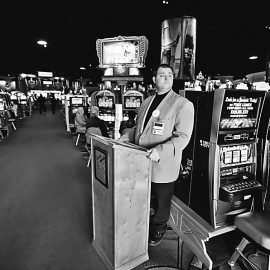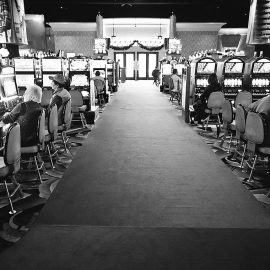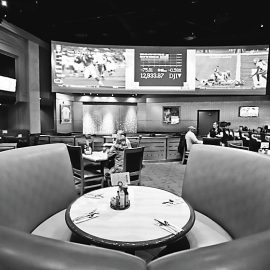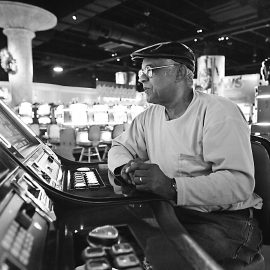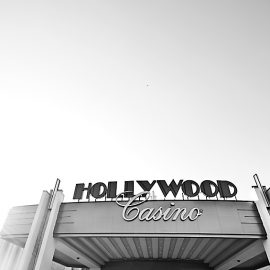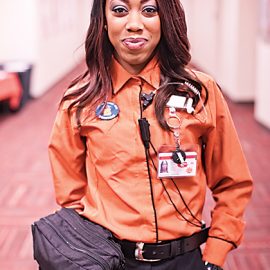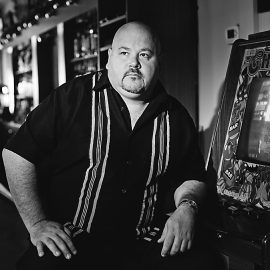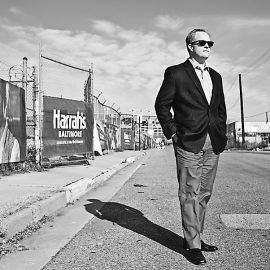News & Community
Doubling Down
Expanded gambling is coming to Maryland, including live blackjack, poker, and roulette, and soon, a Las Vegas-style casino will open in South Baltimore. So, who wins?
Huge empty swaths of gray pavement in the vast parking lot don’t bode well for Perryville’s Hollywood Casino on a warm November Saturday night. Inside the VIP valet parking area, for example, sit exactly 14 cars. Past the front doors and the flashing lights, bells, and whistles, three-quarters of the plush, deep-cushioned chairs at Hollywood’s slot machines are empty as well.
In the casino’s Celebrity Bar & Grill, a pop-rock cover band takes the stage as then-undefeated Alabama and Oregon battle LSU and USC, respectively, on two dozen flat screens, creating a little movement and conversation, but not much. What energy is inside the 75,000-square-foot facility comes from the back of the 2-year-old casino, where small packs of men gather around videotaped images of cleavage-enchanced model/dealers for electronic blackjack.
“It used to be, on a Saturday night, that you couldn’t get a seat at any of the blackjack tables or slot machines,” says Dwain Felts, a Perryville-based contractor in the midst of a minor losing streak. “Now, look around, it’s 10 p.m., and it’s empty.” Hanover’s Maryland Live Casino, he says, which opened in June, pulled away the slot machiners, but as far as the table-game crowd is concerned, most had already returned to competing Delaware Park. “I live in Perryville, and I go to Delaware Park 90 percent of the time,” he says. “Honestly, you feel a little insulted here. With table games, at least you have a real dealer talking to you, real cards. Here, you’ve got a machine talking to you and taking your money.”
Down I-95 on the same night, Maryland Live’s vibe is completely different. Approaching midnight, there’s a steady line streaming inside, and, on either side of the entrance, The Cheesecake Factory and Bobby’s Burger Palace are busy. At the casino’s Rams Head concert venue, people are actually dancing to a cover of Journey’s “Don’t Stop Believin’.”
“ . . . Everybody wants a thrill Payin’ anything to roll the dice, Just one more time . . .”
Meanwhile, 4,700-plus slot machines hum and the curious gather behind those wagering on electronic blackjack and roulette, checking out the action. Attracting approximately 20,000 people daily, Maryland Live is now pulling in $34 million a month (and badly hurting Hollywood Casino). Nonetheless, three days before the Nov. 6 election, the casino’s electronic table-game players voice the same complaint as Felts: They feel cheated out of the full Vegas experience.
“This place is about two or three things away from being a ‘real’ casino,” says 24-year-old Bryan Lovern, splitting a pair of nines with the digital dealer showing seven. “It needs live games and free drinks.”
“You want to be able to play Texas Hold ’Em against other players,” his buddy Vincent Campanaro chimes in. “And it needs a hotel.”
“Maybe hookers, too,” Lovern adds with a laugh.
On election night though, Maryland gamblers got their wish—most of them anyway. Prostitution jokes aside, the passage of Question 7 will bring live table games, 24-hour operations (including 24-hour alcohol sales), Texas Hold ’Em poker—even a World Series of Poker room at the future Baltimore City “Horseshoe” casino—and likely, a resort-style, MGM casino at Prince George’s National Harbor. Of course, there’s the old line about being careful what you wish for. But other than the card sharks and casino owners, who stands to win from expanded gambling, which undoubtedly changes the state’s entertainment landscape, and notably, South Baltimore? And how much more can Marylanders be expected to gamble with Perryville already faltering and three more casinos scheduled to open? Finally, are there social costs to pay?
For someone who stood on the sidelines during the heated Question 7 debate, David Cordish, Maryland Live’s 72-year-old owner, appeared quite pleased strolling, high-roller style, with a buxom blonde on each arm, into a press event a week after the referendum’s passage. The General Assembly had won Cordish’s silence during the election season—in exchange for lower tax rates on slot machines and a much lower tax on revenue from the forthcoming table games—after he protested the addition of a sixth casino in Prince George’s County. Maryland Live may be only 10 miles from Baltimore City, but 40 percent of its customers come from south of the casino [as opposed to north, east, or west]. An animated Cordish was celebrating the arrival of table games, as well as the opening of The Prime Rib restaurant at his casino. A few days earlier, Maryland Live general manager Robert J. Norton said in an interview that replacing electronic table games with live table games has typically boosted table revenues by 20-25 percent at “slots-only” casinos. Slots revenue, coincidentally, also typically increases with the addition of table games.
“We’ve made a commitment to build a world-class facility from a fiscal standpoint and from an amenities standpoint,” Cordish tells the gathered media throng. “The last piece is the table games.”
In fact, table games aren’t really the last piece. Cordish says that future plans for the casino include an adjacent high-rise hotel and conference center, noting Maryland Live currently does not use all of its leased land. The bottom line is more jobs, he points out, highlighting plans to hire 800 dealers and 1,200 new employees overall—while creating a “dealer school” in conjunction with Anne Arundel Community College.
If there was any doubt whether Cordish, whose Baltimore-based company bears his name, believed voters were going to pass the table-games measure, during his press conference he stood behind a genuine green- felt blackjack table—covered with cards and chips—as if he had it waiting all along. Between 30-50 poker tables will be moved into a dedicated poker room, with about 150 table games added overall, says Norton, a University of Nevada, Las Vegas graduate and the son of a gambling executive. The length of three football fields, Maryland Live was designed, Norton adds, in both configuration and size, with the expectation that table games would follow. It just proved to be sooner rather than later.
Cordish, who is also competing for Pennsylvania’s final gambling license, remains adamant that there should’ve been separate Maryland gambling bills, one for table games and one for a sixth casino. Still, he expresses sheer joy at the prospects of live poker, blackjack, and the rest. “Somehow, the whole atmosphere is different,” Cordish says. “I’ve got friends who will say, ‘I only play with a live dealer.’ I have friends who won’t come here because we don’t have live dealers.”
Depending on when the Maryland Lottery and Gaming Control Commission approves regulations, Maryland Live and the state’s other two up-and-running casinos, Perryville and Ocean Downs, should have some table games in place this spring. Ironically, while Hollywood Casino owners Penn National spent tens of millions of dollars to defeat Question 7—to protect their casino interests in Charles Town, WV—legalization may save its Perryville business by keeping Cecil and Harford gamblers at home.
Meanwhile, above the Mason-Dixon Line, Pennsylvania’s gaming industry, which has had table games for two years, posted $3.1 billion in gambling revenues last fiscal year, stealing customers away from Maryland, Delaware, and Atlantic City, where revenue has dropped 40 percent. So, will Maryland’s three “destination” casinos—Maryland Live, Baltimore City, and National Harbor (assuming its application gets the nod)—see a similar gaming boom or cannibalize each other? Cordish won’t make any grand predictions. “Forecasting is virtually impossible,” he says, acknowledging the Perryville, Ocean Downs, and coming Rocky Gap casino will be much smaller operations. “We’ll compete.”
Harford Community College history professor and gambling analyst James Karmel says he always saw the Arundel Mills’ mega- retail complex—drawing 14 million consumers annually—as a perfect casino location. National Harbor, next to Washington, D.C., and Northern Virginia should also do well, he says. The vacant Russell Street lot where Baltimore’s casino will be built, on the other hand, though not far from M&T Bank Stadium, may take more time to thrive. Karmel calls it, “potentially a great site.”
Currently, the area remains largely surrounded by gas stations and warehouses. The hope is that a Harbor East-like mixed-use district will grow around the two-or more-story casino when Caesars Entertainment breaks ground this spring. Originally, Caesars intended to use its Harrah’s brand for the casino, but after Question 7 won the day, the world’s largest casino company increased its investment from $375 million to more than $400 million, upgrading to its newer Horseshoe brand. It also means that the casino—Horseshoe partners with the ESPN-televised World Series of Poker—will host annual, two-week long World Series of Poker circuit events.
Horseshoe’s general manager, Chad Barnhill, has been with Caesars Entertainment for 18 years, including the past few years at a Horseshoe casino in Bossier City, LA. Like Norton, he’s a casino lifer, growing up in Metropolis, IL, and interning at the Caesars-owned Harrah’s there. He says that Caesars wants to bring the Horseshoe brand to more urban centers, with its greater emphasis on table games than its Harrah’s cousin, adding that the Baltimore facility will be similar to a Horseshoe that opened last year in Cleveland and another planned for Cincinnati. It’ll house 3,750 slot machines, more than 100 table games, as well as a 500-seat banquet facility. Construction is projected to create 2,000 temporary jobs and 1,700 permanent jobs.
“The richness and the elegance of the product will be the draw,” Barnhill says. “It’s very table-game centric and very focused on customer service.” The World Series of Poker circuit events, which attract regional players attempting to qualify for the end-of-the-season finale in Las Vegas, he continues, “will bring thousands into the city, booking hotel rooms, adding to the restaurant business, and bringing real benefits to the city.”
Barnhill says for Horseshoe to succeed—competing against casinos in every direction—it needs to become “a part of the pie” luring visitors downtown. Caesars may build a hotel down the road, like Maryland Live, but will rely more immediately on occupancies elsewhere in the city, partnering with existing hotels. They’ll also invite several Baltimore restaurants inside the casino. “We’ll have a great crab-cake place, a great steakhouse, the best slice of pizza in town. Whatever is the best that the city has to offer—we want to be a part of that legacy.” That said, Barnhill says, “We see opportunities, whether it’s for us or other developers, to create more economic opportunities in the area.”
Caesars Entertainment is developing the Baltimore casino, under CBAC Gaming, with co-investors Rock Gaming—owned by Quicken Loans and Cleveland Cavalier owner Dan Gilbert—plus a group of prominent local investors, including Theo Rodgers of A&R Development, Anthony “Tony” Deering of Caves Valley Partners, and Eddie Brown of Brown Capital Management.
Deering, the former Rouse Company chairman and CEO, believes Harbor East serves as a potential model, comparing the casino to the 750-rooms and suites Marriott Waterfront Hotel that served as the catalyst for the still-burgeoning, upscale neighborhood. “There’s four-and-a-half blocks north of the casino, between M&T Bank Stadium [and the casino], that could become an entertainment zone,” Deering says. “Plus, there’s waterfront property behind the casino that could be attractive to a third-party developer.”
Nan Rohrer, vice president of economic development and planning for Downtown Partnership, views the Horseshoe casino as “added value” for the city, providing another option for conventioneers and tourists.
“It’s very complementary with everything else in the city,” Rohrer says, adding with a laugh that the staff at Visit Baltimore, the city’s tourism agency, will certainly love having slots and table games to plug. “If you think about the Red Sox and Yankees fans that come into town, maybe they’ll come a night early, stay over on a Friday, and go to the casino. It’s one more good option for folks coming here to enhance and extend their experience.”
“This development will also change the face of Russell Street, as the
stadiums have done before, improving one of the main entrances to the
city,” says Kimberly Clark, the Baltimore Development Corporation’s
executive vice president. “In and of itself, it’s a huge economic
development with 1,700 jobs, and the amount of money going to the city
will help lower property taxes and improve schools.” Clark noted that
the casino’s rent obligation to the city is 2.99 percent of gross gaming
revenues, with a minimum set forth of $8 million the first year, $10
million the second year, $12 million the third year, and $14 million
thereafter.
The nearby service station and warehouse owners, she says with a small chuckle, “are probably seeing dollar signs now.”
Most
of the concerns by residents around the casino in South Baltimore have
focused on traffic and commitments to hire city residents. But there’s
no organized opposition like Cordish faced in Anne Arundel County.
Barnhill
attended a South Baltimore Neighborhood Association meeting in
mid-November and heard from residents worried about the closing of part
of Warner Street and congestion on Ravens’ game days. However,
Barnhill also says residents have been interested in employment
opportunities. To his point, at a recent zoning hearing, Baltimore
Community Churches United organizer Richie Armstrong, and city activist
Kim Trueheart, inquired about city efforts to ensure construction and
casino-employment opportunities for city residents—not about zoning
changes. State law requires priority hiring for those living within a
10-mile radius of the casino.
Remarkably, in the Question 7
television-ad debate, where some $93 million was spent by competing
casino interests, opposition focused almost solely on whether promised
state revenue would increase education spending. State comptroller
Peter Franchot prominently said there was no such guarantee. Virtually
nothing was said, however, about the likely fallout from expanded
gambling—the expected increase in the number of problem gamblers and
associated uptick in domestic violence, bankruptcy, divorce, theft,
embezzlement, and worse.
According to a SUNY Buffalo study, living
within 10 miles of a casino has a significant effect on problem
gambling and nearly doubles the odds of someone becoming a pathological
or problem gambler. Similarly, a National Gambling Impact Study
reported that Gamblers Anonymous chapters in the U.S. increased from
650 in 1990 to 1,328 in 1998 after a period of rapid gambling
expansion. In Maryland, there are 16 weekly G.A. meetings a week.
Nevada, for example, with less than half of Maryland’s population, has
144.
In too many circumstances, the consequences are serious, says
Leroy Yegge, bar manager at Dempsey’s Brew Pub & Restaurant at
Camden Yards and a long-active member of Gamblers Anonymous.
“I’m
not against gambling. My concern is when people get in over their
head,” Yegge says. “When people are losing the mortgage, the rent,
college tuition, and the bills aren’t getting paid. The thing that
scares me when you bring table games in is that you expand the
demographic. Slots players tend to be older—with the card games, you’re
bringing in more active, younger players, 21-35, gambling more money,
who wouldn’t play slots. You’re going to see guys blowing their
paychecks. Not right away, but in several years, you’ll see the theft,
embezzlement cases, and suicides in the news.”
Yegge, in fact,
says he recently spoke with a compulsive gambler in Boston—a friend of a
local problem gambler—who had literally been on a bridge days before
considering suicide. “His family had no idea,” Yegge recounts. “He’d
lost everything. I had to tell his wife what was happening.”
A
2010 University of Maryland, Baltimore County survey estimated that
roughly 150,000 Maryland adults have experienced moderate to severe
difficulties related to their gambling.
Joanna Franklin, program
director of the new University of Maryland School of Medicine’s Center
of Excellence for Problem Gambling, says that between the mid-1980s and
2011, not a dollar was set aside for treating problem gamblers.
“Maryland was the first in 1979, shortly after the lottery was
established, to offer gamblers and their families counseling, but
budget cuts ended the effort.” Today, she says, the problem-gambling
center is funded by a $1.5 million grant, covering the cost of a
gambling helpline, clinical training programs, research, and prevention
and public-awareness campaigns. The center is also advising the state
on the launch of a treatment program, which Franklin expects to be
announced this year.
In the meantime, slots are already the top
reason why people call Maryland’s gambling helpline. Franklin expects
the number will jump dramatically with increased awareness around
treatment.
And though Maryland just doubled down on its casino
bet, gambling will likely expand again in the not-too-distant future.
Cordish believes Maryland’s casino industry will evolve further, if for
no other reason than the industry itself is already reaching out in
different directions.
Last year, Nevada Senator Harry Reid and
Arizona Senator Jon Kyl, prompted by a Justice Department
reinterpretation of the 1961 Wire Act, began legislation to legalize
online poker. Reversing course, the Justice Department decided that the
law, which has prohibited betting over telecommunications lines, only
applies to sports betting. The ruling creates space for online poker
and other games at the state level, and has the support of gambling
interests, such as Caesars and MGM.
Also, New Jersey wants to
issue sports betting licenses this year—although the NCAA and the major
professional sports leagues have filed suit to stop the action. Since
1992, there’s been a federal ban on sports gambling in all but four
states, including Delaware, where NFL parlay tickets are allowed. New
Jersey is challenging the ban on the grounds that Congress can’t allow a
business to run in certain states but not others.
Stephen
Martino, director of the Maryland Lottery and Gaming Control Agency,
believes it’s only a matter of a time before politicians go after the
revenue that can be generated by legalizing and taxing sports
betting—assuming changes in the federal law. “The numbers on illicit
sports gambling are incredible,” Martino says. “There’s an estimated
$300 billion wagered a year on sports. That’s everything, office NCAA
pools, not just with bookies, but that’s a lot of money.”
New
Jersey’s constitutional challenge is just a start, says Martino, adding
that more states will assuredly follow suit if they win in federal
court. “Clearly, if that happens, and it’s still a big ‘if,’ sports
wagering will start to explode.” If, or when, internet and sports
gambling comes to the state, Caesars and MGM, with their Las Vegas
experience, will be in good positions for the opportunity.
More
immediately, Cordish sees other direct competition coming for
Maryland’s gaming industry. “As soon as the National Harbor casino is up
and running, you’ll see Virginia open one up two miles away on the
other side of the river,” Cordish speculates. “We’ve been in the
gambling business watching this for 20 years,” he says. “It’s a domino
effect.”
The good news is that although Maryland is playing catch
up, William Eadington, University of Nevada, Reno economics professor
and director of the Institute for the Study of Gambling and Commercial
Gaming, believes the market likely has room to grow. “There is a
saturation point, but I don’t think we’re looking at that with the
Baltimore-Washington market,” Eadington says. More than attracting
tourists, he says, it’s important for casinos today be close to
population centers.
Still, will the economic development, the
direct and indirect jobs, and the tax revenue help lift the state and
Baltimore? Or will problem gambling and related social ills exacerbate
current problems? Atlantic City may have been in bad shape before
casinos, but it’s not exactly thriving today either.
“Yes and
yes,” says Franklin. There’s going to be additional jobs, revenue, and
development. There’s also going to be social costs. “With additional
gambling, the prevalence of problem gamblers, the 3.4 percent in
Maryland, will likely increase a little,” Franklin says. “Will the
social costs outweigh the benefits? It’s inconclusive, because
nobody—not the social scientists or the economists—can agree on what set
of figures to use. Studies have put the social cost at anywhere
between $5,500 and $30,000-60,000 per problem gambler. But one study
calculated the cost of divorce, for example, by just using the cost to
file for a divorce.
“Is that really the cost of a divorce?”
“So
the answer is really that it is good, and it is bad,” Frankin
continues. “There’s an upside and a downside. The best thing we can do
at this point is put all the apparatus in place to help people who are
going to need help.
“Gambling is here.”
